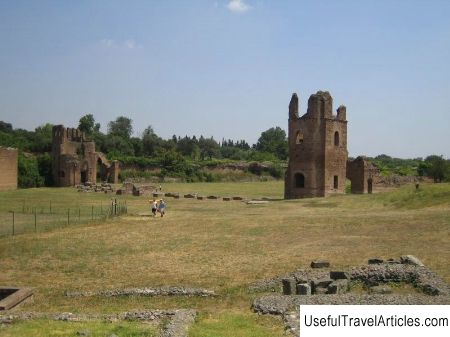Catacombs of Saint Callistus in Italy, Rome resort
Rating: 8,4/10 (298 votes)  The Catacombs of Saint Callistus are one of the largest Christian catacombs in Rome. The catacombs are located on the territory of the Old Appian Way. For burials, the catacombs were used from the 2nd to the 4th centuries. Today the catacombs contain many inscriptions and frescoes testifying to the life and deeds of members of the Christian community that existed in the first centuries of the new era. The complex of the catacombs was formed on the basis of some previously existing burials. Over time, the complex expanded and by the end of the 4th century it merged into a single network. Initially, the area of the future catacombs was a private property, but soon the landowners who converted to Christianity transferred the lands to the church. The idea of arranging a cemetery on this territory belonged to the Roman bishop Zephyrinus. Deacon Callista took over the management and organization of the complex. His duties included the worthy burial of every deceased Christian, the funeral of the poor while carried out at the expense of the church. After the death of Zephyrinus, Callistus became his successor. Soon he improved and significantly expanded the catacombs. The most ancient parts of the catacombs – crypt of Lucina and sections that include the crypt of Saint Cecilia, the crypt of the Popes, cubicles of the Holy Mysteries. In the III century they were combined with the sections of Saints Eusebius and Gaius, and in the IV century – section of Saint Liverius. Almost from the very beginning, the catacombs played a double role in the life of the church community. On the one hand, they were a cemetery, on the other – a place of pilgrimage. In the days of the memory of the martyrs, in accordance with ancient traditions, divine services were performed on their tombs. The tombs of the martyrs were visited on other days as well, as evidenced by numerous inscriptions and images. In V – In the 9th century, the relics of the revered saints were removed from the catacombs. In 609, about 30 carts with relics were transported to the Pantheon by Pope Boniface IV. Until 1854, the catacombs were completely closed. Since then, the catacombs have been actively studied. To date, the total area of the studied territory of the catacombs is more than 36 hectares, the length of the investigated corridors – 21 kilometers. In our time, only a small part of the catacombs of St. Callistus is open. In the standard excursion program, tourists are presented with the Crypt of the Popes, the Ladder of Pope Damasius, the Crypt of St. Cecilia, Cubicles of the Sacraments, the Section of St. Miltiades.     We also recommend reading Church of San Francesco a Ripa in Italy, Rome resort Topic: Catacombs of Saint Callistus in Italy, Rome resort. |




